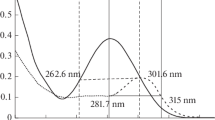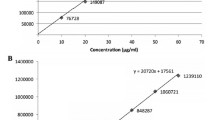Summary
The influence of the method used for determination of drugs in biological fluids on the pharmacokinetic parameters of sulphadimethoxine was investigated in healthy adult human subjects. Sulphonamide concentrations were determined by four chemical methods: high performance liquid chromatography (HPLC) and three spectrophotometric techniques, i.e. Bratton-Marshall original method as well as Rieder’s modification and author’s modification of the Morris technique. The compatibility of pharmacokinetic parameter values calculated from these results was good, the correlation coefficients between HPLC and all spectrophotometric methods were high. It has also been shown that the phenotype of acetylation as well as moderate cigarette smoking which can induce some enzymes responsible for the formation of glucuronide conjugates, i.e. main metabolic pattern for sulphadimethoxine, does not affect the half-time of this drug.
Similar content being viewed by others
References
Bennett J.V., Brodie J.L., Benner E.J., Kirby W.M.M. (1966): Simplified accurate method for antibiotic assay of clinical specimens. Appl. Microbiol.,14, 170–177.
Malmborg A.S., Rane A. (1984): Comparative determination of sulfonamide concentration in serum by chemical and microbiological assay. Scand. J. Infect. Dis.,16, 309–314.
Bratton A.C., Marshall E.K. (1939): A new coupling component for sulphanilamide determination. J. Biol. Chem.,128, 537–550.
Rieder J. (1972): Quantitative determination of bacteriostatically active fraction of sulfonamides and the sum of their inactive metabolites in the body fluids. Chemotherapy,17, 1–21.
Klimowicz A. (1986): Spectrophotometric method of determination of active sulphonamide concentration. Diagn. Lab.,22, 163–167 (in Polish).
Sigel C.W., Grace M.E., Nichol C A., Hitchings G.H. (1974): Specific TLC determination of trimethoprim and sulfamethoxazole in plasma. J. Pharm. Sei.,63, 1202–1205.
Vree T.B., Hekster Y.A., Baars A.M., Damsma J.E., van der Kleijn E. (1978): Determination of trimethoprim and sulfamethoxazole (cotrimoxazole) in body fluids of man by means of high performance liquid chromatography. J. Chromatogr.,146, 103–112.
Astbury C., Dixon J.S. (1987): Rapid method for the determination of either plasma sulphapyridine or sulphamethoxazole and their acetyl metabolites using highperformance liquid chromatography. J. Chromatogr.,414, 223–227.
Essers L., Korte H. (1982): Comparison of the conventional methods and high performance liquid chromatography for the determination of trimethoprim, sulfamethoxazole and its metabolite in serum. Chemotherapy,28, 247–252.
Rieder J. (1973): Metabolism and techniques for assay of trimethoprim and sulfamethoxazole. J. Infect. Dis.,128 Suppl, S567-S573.
Morris C.J.O. (1941): The determination of sulphanilamide and its derivatives. Biochem. J.,35, 952–959.
Gibaldi M., Boyes R.N., Feldman S. (1971): Influence of first-pass effect on availability of drugs on oral administration. J. Pharm. Sei.,60, 1338–1340.
Evans D.A.P. (1969): An improved and simplified method of detecting the acetylator phenotype. J. Med. Genet.,6, 405–407.
Fleischmann R., Remmer H., Starz U. (1986): Induction of cytochrome P-448 iso-enzymes and related glucuronyltransferases in human liver by cigarette smoking. Eur. J. Clin. Pharmacol.,30, 475–480.
Vree T.B., Hekster Y.A., Tijhuis M.W., Baakman M., Oosterbaan M.J.M., Termond E.F.S. (1984): Effects of methoxy groups in the N,-substituent of sulfonamides on the pathways of elimination in man. The acetylationdeacetylation equilibrium and mechanisms of renal excretion of sulfisomidine, sulfamethomidine and sulfadimethoxine. Pharm. Weekbl.,6, 150–156.
Bridges J.W., Kirby M.R., Williams R.T. (1965): The structure of the glucuronide of sulphadimethoxine formed in man. Biochem. J.,96, 829–836.
Bridges J.W., Kirby M.R., Walker S.R., Williams R.T. (1968): Species differences in the metabolism of sulphadimethoxine. Biochem. J.,109, 851–856.
Rieder J. (1963): Physikalisch-chemische und biologische Untersuchungen an Sulfonamiden. I. Pharmakologisch interessante physikalisch-chemische Merkmale von 21 Sulfonamiden und 6 Sulfonamid-Metaboliten. Arzneim.-Forsch.,13, 81–88.
Author information
Authors and Affiliations
Rights and permissions
About this article
Cite this article
Klimowicz, A. The comparison of some pharmacokinetic parameters of sulphadimethoxine estimated by high performance liquid chromatography and three spectrophotometric methods. European Journal of Drug Metabolism and Pharmacokinetics 14, 181–186 (1989). https://doi.org/10.1007/BF03190097
Received:
Issue Date:
DOI: https://doi.org/10.1007/BF03190097




